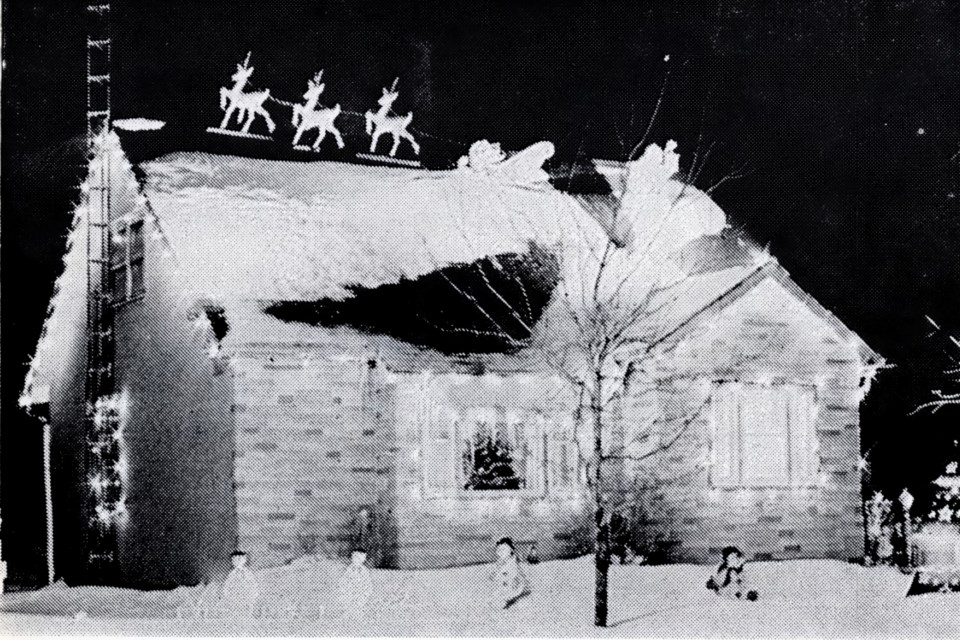It’s that time of year again … Christmas cards, Christmas trees and decorations, alimentary overindulgence and, to the delight of some and the chagrin of others, non-stop Christmas music everywhere (I’m looking at you Mariah Carey and Michael Bublé).
These “traditions” are all fairly recent in the grand scheme of Christmas, but they (and their consistency) are what gives the Yuletide season that warm and fuzzy feeling with which we can wrap ourselves in like a comfortable ugly Christmas sweater.
A year ago, we took you on a downtown shopping trip through the ages. This year, we would like to stick a little closer to home, with a Christmas-twofer (no not that kind of two-four … though many have used that as a tradition to get through the holidays), and reminisce about the twin family traditions of dinner and decorations, which don’t make Charlie Brown cry out “Good Grief” and lament the commercialization of the holiday.
To start our sentimental journey, as we near the end of Sudbury’s 140th year, let us go all the way back to the beginning, to the very first Christmas in Sudbury Junction.
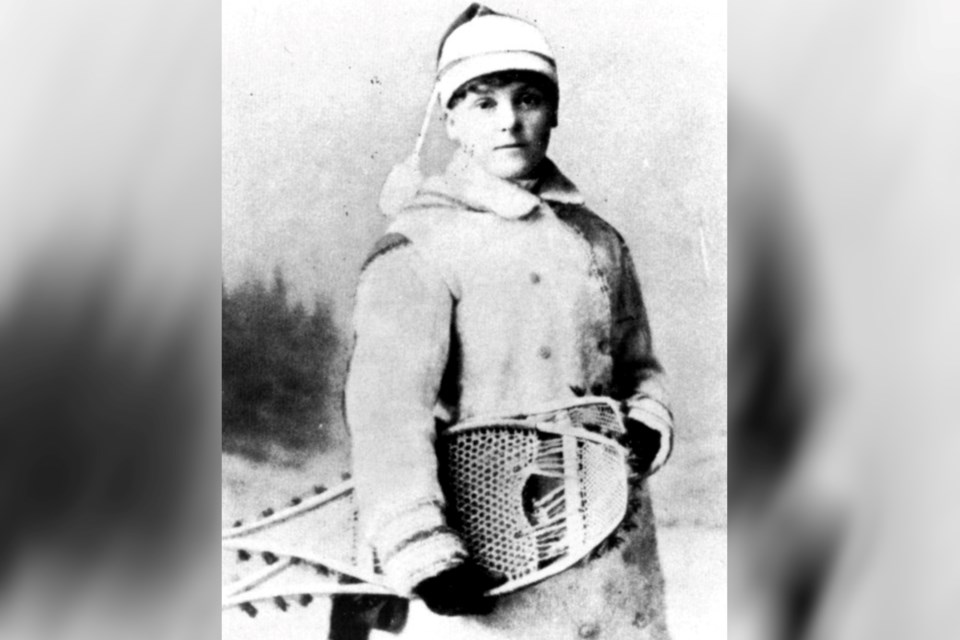
The site is the Howey Log Cabin. Florence Howey is our host and what follows is her account of that first Yuletide around 1883.
Nearly six months of isolation in the burgeoning community was slowly coming to an end with the arrival of the CPR tracks the previous month. What better way to celebrate than to have a party?
Eleven residents were invited, made up of “several fellows who could not leave and were looking kind of homesick.” The house was made up, Miss Horrigan (“the only girl available”) decorated, making "a woodland bower of our little room, with cedar and balsam boughs." A "Merry Christmas" made of cedar, extended nearly the length of one log on the side of the room. Such an ostentatious event required arrangements of the utmost detail.
Even though the table comfortably accommodated eight, with the 11 invited, a plan was hatched to distribute "the fat and lean guests judiciously and sitting very close together on the benches."
Apparently, the "Merry Christmas" of cedar was the centre of attention, particularly as the final ‘S’ was backward. This was soon reversed while everyone awaited dinner.
The main attraction of dinner, the turkey, was compliments of Dr. Girdwood, general supervising physician for the Canadian Pacific Railway. At the appointed time, the man of the hour, the turkey carver, arrived forthwith "carrying the platter high, (marching) solemnly around the table, proclaiming about St. Nicholas and a turkey, until the company protested that they would rather eat it than hear about it".
Mrs. Howey later commented, "All were in good spirits, although we were a bunch of strangers gathered from every direction, away back in the wilderness, hundreds of miles from any kin or friends." Though they were isolated, a traditional Christmas dinner had been shared. They all sang "Auld Lang Syne" and the evening drew to a close with all agreeing that they indeed had had a Merry Christmas.
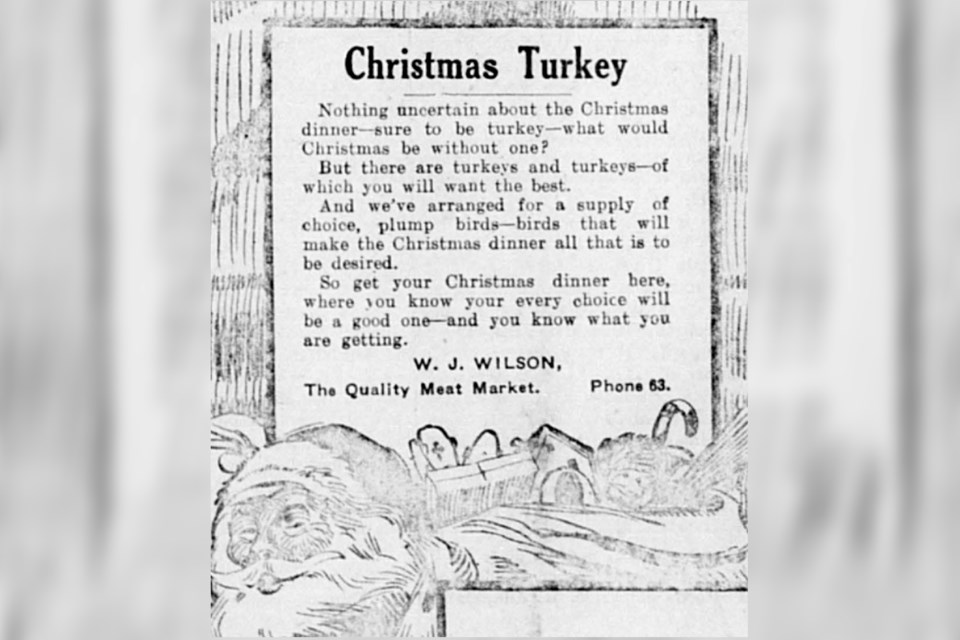
Some would say that the true magic of Christmas can be found in that adopted Germanic tradition of the family Christmas tree. After all, a neatly trimmed tree (and the process that goes into its construction) builds as many memories as the gifts that can be found underneath it.
At the turn of the last century, Christmas trees most closely resembled those of their origins, families would bind real candles to the boughs with wire or clip-on hardware and light them for a soft glow. And, if a family happened to be able to afford carpeting in their living space, it was expected to place a piece of tin under the tree to collect the melted wax. Only the wealthy had money to spend on fancy lights and glass ornaments. As a result, most families made Christmas tree decorations by hand from paper, ribbon, cranberries, popcorn, and even painted walnut shells.
By the Roaring Twenties, it was common, given the lavish time period, to trim the Christmas tree with lots of decorations such as ribbons, satin balls, and glittered stars. Many residents, emboldened by the happiness of the post-Great War years, would head on down to stores such as F.W. Woolworth’s on Durham Street (perhaps after mailing out Christmas greetings at our grandiose Post Office nearby) to select from the finest glass ornaments on display.
Unfortunately, this lavishness was not to last for many as the next two decades brought austerity out of necessity to the Christmas traditions, with the Great Depression followed closely by the Second World War.
In the midst of the Great Depression, people turned to their pantries for edible decorations: popcorn balls and cranberry garlands were all derived from old European traditions brought over by new residents of the Donovan and the Flour Mill.
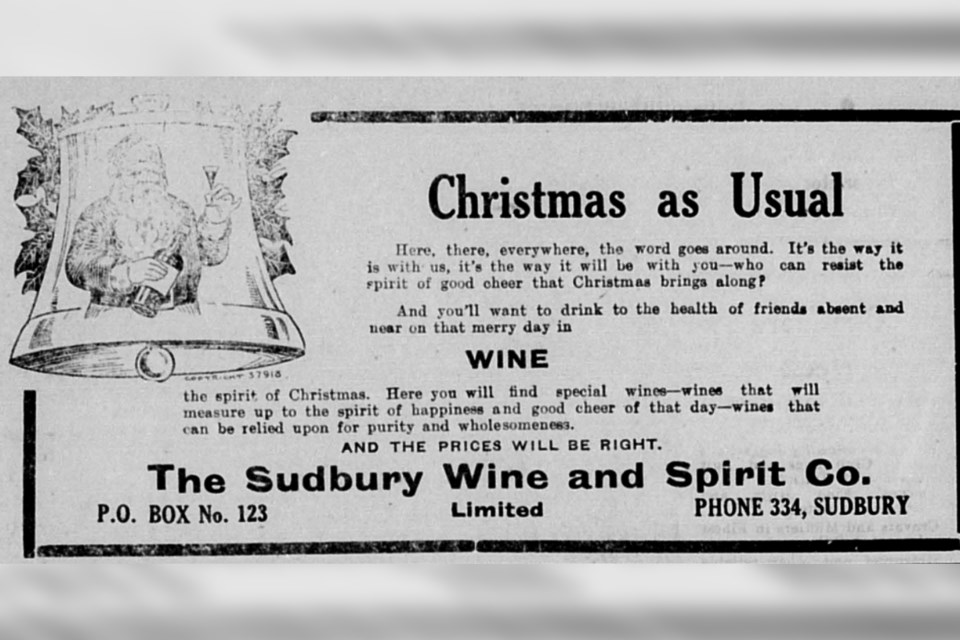
While in the early years of the War, rationing necessitated the replacement of an ornament's metal cap (collected during scrap drives) with a cardboard tab, from which the owner would use yarn or string to hang the ornament. By this time, it also became a tradition for many homes to trim the tree as a family.
An unfortunate aside to Christmas traditions of the mid-20th century was that for over a decade, you could buy boxes of fake snow (remember that flocking that you would sprinkle on your tree?) with names like “White Magic,” and “Pure White.” This “snow” was made using asbestos.
The post-war Baby Boom, industrial mass-production and suburban expansion brought with it a change in Christmas tree traditions. They began to be decorated with hard plastic ornaments, candy containers, and illuminated figures. And the finishing touch? Having a small model train chug along its tracks around the base of the tree was a tradition that inspired homes and department store window displays alike. And, if you were to tell someone that you were going to pick up Christmas decorations, it was most likely at one of those two venerable local department stores, F.W. Woolworth on Durham and S.S. Kresge on Elm, which resided within a stones-throw of each other.
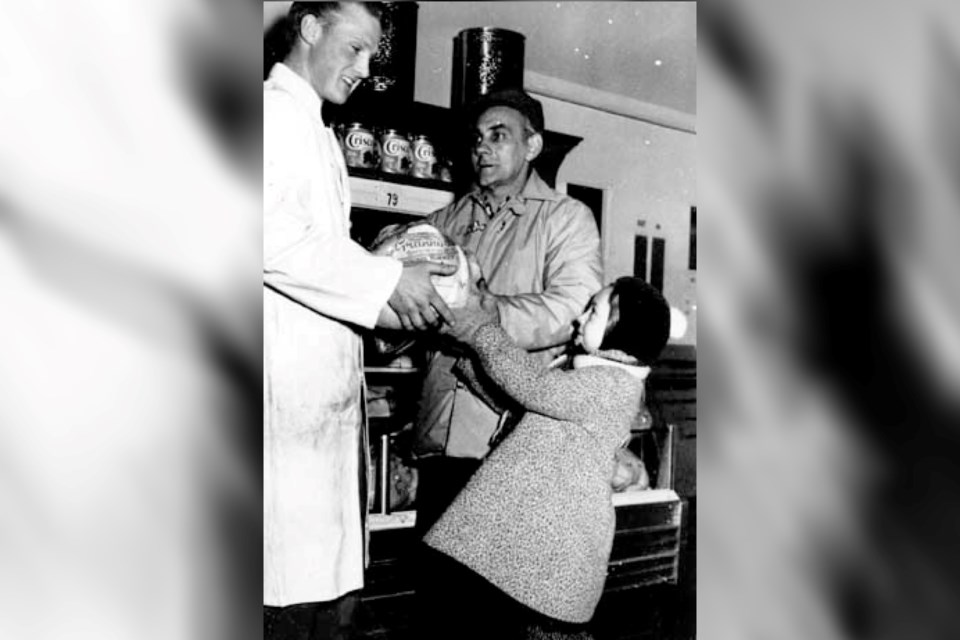
Durham Street itself at the time was a perfect example of a mid-century Christmas aesthetic, being the most decorated street in town. The mixture of the Yule-specific lighting and the various stores’ neon lights reflecting off the falling snow, as well as the plentiful Christmas displays in the windows of nearly every store, did much to heighten the Christmas spirit.
These commercial lighting displays, along with the post-War suburbanization across the city, also kickstarted a new tradition.
Decorating the outside of one’s home with long strings of lights and hard plastic versions of Christmas characters (snowmen, reindeer and Santa) for all to enjoy became as important for some as the decorated contents of their home. And, with that, the Christmas lights competition was born and the strength of the December electricity grid was never the same again (at least until the advent of LED lighting).
With the Sixties, came a real revolution in the traditions of Christmas decorations. Artificial trees, some of them flocked in white, started to become popular in many households. Aluminum Christmas trees came out at the height of the Vietnam War era and inspired Lucy to ask Charlie Brown to “get the biggest aluminum tree you can find … maybe painted pink.”
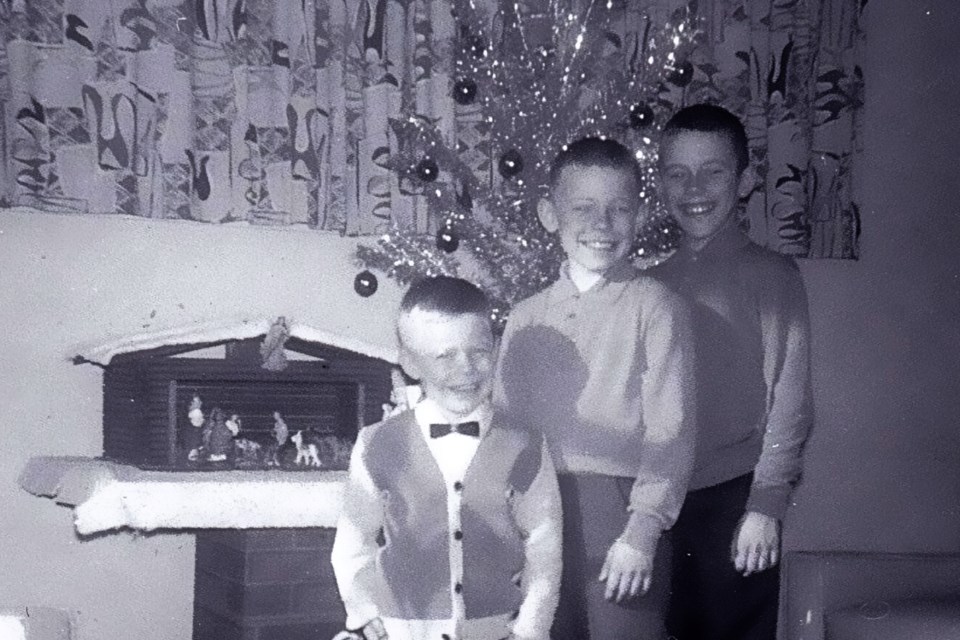
Since these shiny silver trees were less hassle and mess than the real deal, they became very popular.
During this decade, the Zellers store, which replaced the Balmoral Hotel at the corner of Elm and Elgin Streets, welcomed shoppers to visit Santa’s Toyland, with a decorated street-side window that was even anchored by a tree nearly reminiscent of the one that got Charlie Brown in trouble.
Thankfully, the Peanuts Gang were able to help reverse this trend and by the 1970s real (and natural-looking) trees had returned to favour. With the entrance of the City Centre onto the scene, that Eaton’s store that everyone used to flock to on Durham Street took its top-notch Christmas tree displays (which inspired many-a-shopper in their own Christmas decor choices) and moved to the corner of Elm and Notre Dame.
This decade and those that followed brought about the collectors’ mentality to Christmas decorating with the advent of the “winter village” collections, sold in locations such as Eaton’s, that allowed people to design their own mini nostalgic winter wonderland on the mantelpiece. This was followed by the “keepsake ornament” tradition that caused many Christmas collectors to be waiting patiently for the day that they could visit the Hallmark store in the New Sudbury Centre to check out the new arrivals and decide whether to continue with a specific limited edition ornament collection.
Let us now come full-circle to the story of the first Christmas.
Through the years, Christmas dinner often resulted in a feast that all-to-often could attack a family’s pocket book. During Florence Howey’s time, The Ark on Cedar Street was a popular source of holiday provisions and groceries. There, one could collect all the provisions needed to produce multiple Christmas delights: apples, biscuits, eggs, sugar and flour for less than $2.
At the turn of the century, the "East End Meat Market" near Elm and Lisgar Streets advertised a number of Christmas specials. One ad began "Down comes meat! Meat has taken a tumble to itself, but the further it tumbles the better in quality it gets.” At the market one could find many of the essentials for a high-quality Christmas dinner: beef, pork, mutton, lamb, poultry, and fresh Lake Superior trout.
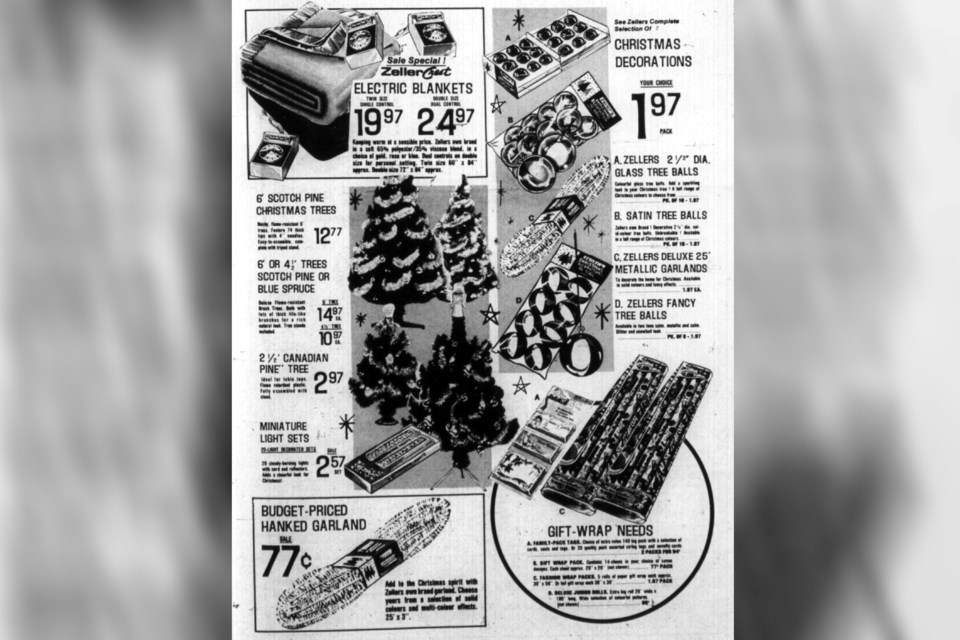
In 1958, Christmas traditions almost broke down entirely with the Mine Mill strike against INCO. Fortunately, the community banded together to help each other, with store owners giving lines of credit, others sharing produce they grew in their gardens with those who needed food and women making Christmas dinners for neighbours.
In the weeks before Christmas, the Mine Mill handed out 8,000 food vouchers, and the Salvation Army and city churches collected food for the strikers' families. Luckily, just days before Christmas in 1958, some 14,000 Sudbury miners and their families received the news: the three-month strike at Inco was over.
By Christmas Eve, the stores were buzzing with last-minute shoppers, planning the dinners they never expected would happen.
By the Seventies (and with an eye towards the next INCO strike which came in 1978), Christmas feast planning was presaged by the search for deals for the discerning shopper. One could visit “Dollar Days” (“Pass the Buck to Dominion”) at one of the four Dominion stores around town, where, like the East End Meat Market before it, “It’s mainly because of the Meat!” Or, if a dollar wasn’t to your liking, you could hit the $1.44 specials at IGA for all of the fixings to go along with your Christmas turkey.
Of course, you could head on over to Towers at the opposite end of the City Centre from Eaton’s and pick up a deluxe fruit cake (“Makes a great Christmas present”) … if you really wanted to lose friends).
Well dear readers, as Christmas draws near, we would love to know, what do you remember most about Christmas? What are some of your family traditions that were passed on from your ancestors and that you have passed down to your children and grandchildren? What were your favourite sights, sounds and smells of the season? Share your memories and/or photos by emailing them to Jason Marcon at [email protected] or the editor at [email protected]
Jason Marcon is a writer and history enthusiast in Greater Sudbury. He runs the Coniston Historical Group and the Sudbury Then and Now Facebook page. Memory Lane is made possible by our Community Leaders Program.
